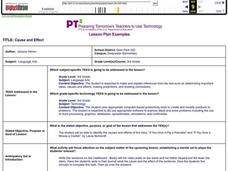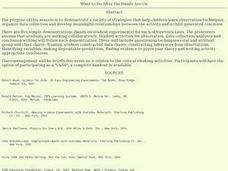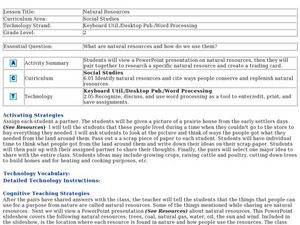Curated OER
Black History Month
Students work in cooperative pairs to research information and give oral presentations about African American men and women who have made significant contributions to U.S. history.
Curated OER
Density of a Sinker
Eighth graders determine the density of a sinker by first finding the mass and then the volume using a graduated cylinder. Students must write the procedure they use to find the volume of the sinker then apply their data to follow-up...
Curated OER
Cause and Effect
Students identify cause and effect relationships in a short story. After reading a short story, they participate in a discussion of how one event in a story can lead to several others. Students are then paired for a matching task that...
Curated OER
History by Heroes
Middle schoolers role play one of the Presidents between 1877 and today. Individually, they use the internet to research the President through official documents, political cartoons and various editorials. Throughout the year, they are...
Curated OER
With malice toward none, with charity for all: The life of Abraham Lincoln
Students research Abraham Lincoln in a variety of ways. For this Abraham Lincoln lesson plan, students use primary sources, vocabulary activities, books, and more to research and learn about Abraham Lincoln.
Curated OER
Cause and Effect
Third graders identify the causes and effects of the story, "If You Give A Pig a Pancake" and "If You Give a Mouse a Cookie", by Laura Numeroff. They write a cause and effect story using Kidspiration.
Curated OER
Epidemiology: Graphing and Analyzing Health Data
Students graph data on fetal and infant mortality rates collected by the Centers for Disease Control and Prevention. They identify trends in the data and propose potential causes for the trends.
Curated OER
Secrets from the Sea
Learners utilize technology for research. They research the potential causes of the sinking of the Hunley.
Curated OER
Could You Repeat That?
Students participate in an oral story telling activity designed to show how story embellishments occur. They read "Beowulf" and identify incongruities that suggest additions and embellishments over the years.
Curated OER
Digging Deeper in Mission San Saba
Seventh graders explain Spanish motives for establishing Mission San Sab?? and the reasons for the mission's failure. This lesson should be used when students already have an understanding of the Spanish mission-presidio system in Texas.
Curated OER
Stones, Bones & Telephones: Analyzing Artifacts Using Bloom's Taxonomy
Seventh graders define metacognition, Bloom's Taxonomy, and artifacts. They, in groups, try to identify a mystery artifact using the Artifact Analysis sheet. They present their findings to the class.
Curated OER
What To Do After The Hands-Are-On
Students perform various demonstrations for each of Newton's Laws, collect data, and write a conclusion for each.
Curated OER
Living on a Cotton Farm: Mexican Americans Life In Texas
Seventh graders are introduced to the processes of cotton farming in the early 20th century. In groups, they examine the role of Mexican Americans on the farms and the impact of a boom and bust economy on cotton. They identify the...
Curated OER
Analyzing Artifacts Using Bloom's Taxonomy
Seventh graders apply Blooms Taxonomy to analyze a collection of artifacts. They define and discuss the nature of artifacts and work in groups to complete handouts. Students analyze an object (stone pipe) on a mystery artifact analysis...
Curated OER
Choosing the Best Graph
Eighth graders produce and examine two sets of data and create what they believe to be the most appropriate graphs to represent these sets of data. After completing the pre-assessment, they discuss reasons for using each type of graph...
Curated OER
The Study of the Spanish-Speaking People of Texas: Overcoming Adversity
Students examine the photographs of Russell Lee and identify the obstacles faced by Mexican-Americans in Texas during the early and mid-20th century. They discuss the ways they overcame these obstacles and relate it to obstacles in...
Curated OER
Identify Plant Nutrient Requirements
Learners are given standard elemental nutrients, identify plant nutrient requirements based on criteria outlined in assessment instructment. They, are given standard elemental nutrients, provide all means and chemical symbols of plant...
Curated OER
Habitat
Pupils are able to define habitat. They are able to identify the four things that living things need to survive. Students are able to describe how living things are adapted to their habitats.
Curated OER
War In Iraq Comparison
Fifth graders use the internet to research the Silver Star given to those who served in Operation Iraqi Freedom. Using the information, they write a short report on one of the recipients of the Silver Star. In groups, they visit a...
Curated OER
Roles of the President
Students read a document which explains the roles and responsibilities of the President of the United States. In groups, they tour the George Bush Presidential Museum and participate in a Presidential scavenger hunt. Once back in the...
Curated OER
Natural Resources
Fifth graders begin the lesson by identifying the different types of natural resources. As a class, they discuss how environments are destructed and how the loss of one natural resource can affect the economy. Using a map, they label the...
Curated OER
National Debate Over Treaty Ratification
High schoolers review the main points of the Versailles Treaty. In groups, they analyze a variety of political cartoons about Wilson and the treaty itself and share their findings with the class after completing a worksheet. To end the...
Curated OER
World War II Through Primary Sources
Seventh graders explore, analyze and study World War II through primary sources to assess the differences and impact of a "world war" vs. "a small war." They critique liberated prisoner letters, describe what they see in photographs and...
Curated OER
The Seasonal Round and The Cycle of Life
Fourth graders are introduced to the concept of the seasonal round and how folklife traditions vary from season to season. They begin charting dates of personal interest on seasonal round calendars by starting with birthdays. Students...

























